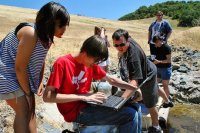Change the Subject: Making the Case for Project-Based Learning
What should students learn in the 21st century? At first glance, this question divides into two: what should students know, and what should they be able to do? But there's more at issue than knowledge and skills. For the innovation economy, dispositions come into play: readiness to collaborate, attention to multiple perspectives, initiative, persistence, and curiosity. While the content of any learning experience is important, the particular content is irrelevant. What really matters is how students react to it, shape it, or apply it. The purpose of learning in this century is not simply to recite inert knowledge, but, rather, to transform it.1 It is time to change the subject.
This is no small matter. For more than a century, the whole point of schooling has been to restrict the curriculum, specify the required content, and limit the entry points to it -- often by means of a watered-down, already obsolete text, mediated by a classroom manager whose task is to transmit the subject matter to 30 or more individuals of diverse backgrounds, experiences, interests, and resources. This is particularly true of the "big four" core subjects that the Carnegie Commission decided, nearly a century ago, to be the subjects that matter. English, math, science (biology, chemistry, and physics), and social studies count for much, and the fine and practical arts for much less.
Expanding the "Big Four"
Why not study anthropology, zoology, or environmental science? Why not integrate art with calculus, or chemistry with history? Why not pick up skills and understandings in all of these areas by uncovering and addressing real problems and sharing findings with authentic audiences? Why not invent a useful product that uses electricity, or devise solutions to community problems, all the while engaging in systematic observation, collaborative design, and public exhibitions of learning?
It has long been axiomatic in the United States to separate students according to perceived academic ability, to separate academic from technical teaching and learning, and to isolate adolescents from the adult world they are about to enter. Instead, our aim in this century should be to integrate students by eliminating tracking, to integrate the subjects via problem-focused experiences, and to integrate school with the world beyond through fieldwork, service learning, and internships.
What might students do in such schools, in the absence of prescribed subjects? They might work together in diverse teams to build robots, roller coasters, gardens, and human-powered submarines. They might write and publish a guide to the fauna and history of a nearby estuary, or an economics text illustrated with original woodcuts, or a children's astronomy book. They might produce original films, plays, and spoken word events on adolescent issues, Japanese internment, cross-border experiences, and a host of other topics. They might mount a crime scene exhibition linking art history and DNA analysis, or develop a museum exhibit of World War I as seen from various perspectives. They might celebrate returning warriors, emulating the bard in Beowulf, by interviewing local veterans and writing poems honoring their experiences. The possibilities are endless.
The Value of Changing the Subject
In executing such projects, students develop deep understandings by making something new of their subject matter. Of necessity, they learn how to collaborate, how to plan, how to give and accept critique, how to revise, how to self-assess. They read complex texts and write a wide range of pieces for a variety of purposes, from personal reflections to news articles, project proposals, memos, research reports, stories, and essays. They interview community members, learning to listen and appreciate diverse perspectives. As they present their work to important audiences, they come to understand what it means to be a member of the human community. And the irony is that as students pursue their passions and interests, the curriculum springs back to life.
Changing the subject, then, means deriving the curriculum from the lived experience of the student. In this view, rather than a collection of fixed texts, the curriculum is more like a flow of events, accessible through tools that help students identify and extract rich academic content from the world: guidelines and templates for project development, along with activities and routines for observation and analysis, reflection, dialogue, critique, and negotiation.
Unleashing the Future of Education
If we are to change the subject in this way, then we must change the trappings within which we educate our youth. It is a fool's errand to expect teachers to model 21st-century skills in a 19th-century work environment. Instead, situate them where they can collaborate with other teachers -- and with their students -- to pose problems, engage expert assistance, and design products and performances of lasting value. Embrace a cohort model, where teams of teachers and students work together. Build professional collaboration and development time into the daily schedule, so that teachers can meet variously in teaching teams, academic departments, and study groups to reflect on and refine their day-to-day practice. The aim is to unleash teachers -- and their students -- to design learning experiences that are applied, integrated, situated, expeditionary, and alternatively assessed.
When we learn -- really learn -- we transform the content, the self, and the social relations of teaching and learning. This is what it means to change the subject. We can do this. If we value our future, we must.
Notes & Reference
1As we look forward in the 21st century, it can be instructive to look back. In “The Rhythmic Claims of Freedom and Discipline,” first published in 1922, Alfred North Whitehead cautioned against the mere teaching of subjects for “inert knowledge.”
Whitehead, A. (1967). The Aims of Education and Other Essays. New York: Free Press (reissue edition).
Larry Rosenstock contributed to this post. Larry is CEO and founding principal of High Tech High, a network of eleven K-12 public charter schools in California, and is Dean of the High Tech High Graduate School of Education.
